Supporting materials
Stone Age activities (Word document)
Stone Age activities (PDF file)
Download
Download this article as a PDF

Taking pupils out of the classroom opens up a whole range of activities for teaching young children about the natural world.
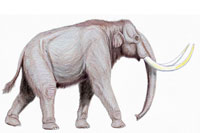
The Stone Age might not have been a fun time to live in for our ancestors, but finding out about it can be an enjoyable and educational experience for younger children.
For the past decade, my colleagues and I have run an educational initiative called ‘a week on the meadow’ in our small school, which caters for pupils aged 6-18 who have special educational needs. It started life as a break from routine, a chance to give the younger children a breather from the daily timetable of classroom-based learning. But it has evolved into an educational tool for teaching a wide range of topics centred on science, and one we think can be easily adapted for primary-age children of all abilities.
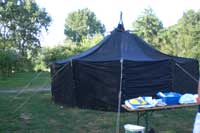
Every year, for a week in spring or summer, two classes of mixed-aged pupils (ages 6-11), 20 to 30 children in all, swap the classroom for a nearby meadow to learn in the open air. Initially, my colleague and I ran the project alone; in the past few years, we have had the help of a trainee teacher and a university student. We also have the support of a local farmer, who lends us the meadow and gives us access to his fields, and a local scout group who provide us with a yurt in case it rains. With these simple facilities, we spend our days learning about nature, focusing on a different theme each year. In 2010, we investigated life in the Stone Age.
Although we are teaching children with special needs (such as learning disabilities, concentration problems and movement disorders), the beauty of the week on the meadow is that it can incorporate a whole range of activities pitched at different interests and ability levels.
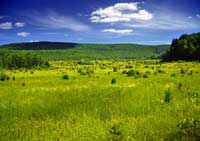
A meadow with nearby trees and a stream is ideal, because it can be used to teach a range of topics including plants, insects, nutrition and even building simple structures. However, the concept is flexible enough to be adapted to a range of locations and subjects – in previous years, we have used the themes of pirates, knights and ladies, the Middle Ages, horses, farm animals, ships, flight and the Olympic games. And if you don’t have access to a meadow, you could perhaps use a local park.
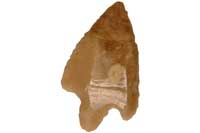
The project begins a week before we head to the meadow, with a box of books about our chosen theme: in this case, the Stone Age. As a class, we talk about different aspects of our chosen topic: for example, about the landscape, the wildlife that roamed over it and how humans lived at the time – hunting animals, gathering plants, living arrangements, family life, tools and so on. Keen children can do some extra reading in their free time.
The real fun starts when we arrive at the meadow on the first day. On arrival, the children can freely explore the area they will be getting to know over the next few days. Conditions are a lot more basic than the kids are used to. For the first few years that we ran the project, we didn’t even have toilets; instead, the children dug a latrine and built a screen out of sticks, grass and leaves. Even once the farmer had provided portable toilets, we still managed without clean running water: for washing hands and food, we took water in canisters; for washing paintbrushes, we used water from the stream. It is certainly useful to have a shelter (we used a yurt) to store equipment overnight, or for the pupils to shelter in during the day if it rains, but otherwise the infrastructure requirements are minimal. Indeed, the basic conditions can actually be turned into a learning experience. And of course, it makes the pupils appreciate their return to the 21st century when they go home each evening.
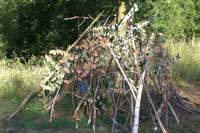
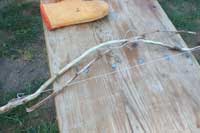
For several of our themes, a big part of the project has been finding out about how people fed themselves. This is a great chance for interdisciplinary learning, which combines a wide range of activities that can be tailored to different levels, covering different topics across science and technology.
For example, in our Stone Age project, one group activity involved learning about hunting. The hunters’ group – which was popular with girls as well as boys – made bows and arrows out of branches and stringw1, and learned how to use them. Having a small forest nearby to gather sticks and branches from was a big help, but of course it would also be possible to provide the raw materials from elsewhere if necessary.
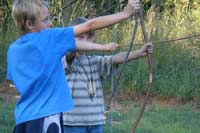
This activity offers considerable opportunity for experimentation and problem solvingw2. Which kind of wood works best? How thick? How dry? And how best to shoot the arrows? Is it better to fire upwind or downwind? Should you aim horizontally or upwards? Do feathers make the arrow fly straighter? The pupils spontaneously asked many of these questions themselves, but teachers can also help to structure the exercise by making suggestions and pointing the children in the right direction.
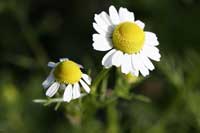
Of course, the companion to hunting is gathering. We have tried a range of gathering activities in several of our weeks on the meadow, as a way to learn more about plants and food. For example, one group collected herbs, such as chamomile, mint and lemon balm for infusions. A lot of children were not familiar with these, so we held a tasting session and smelled the plants before and after steeping in hot waterw2.
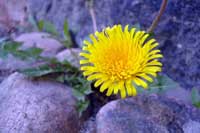
Another group gathered edible leaves such as dandelions to make a salad, which the class ate together. A third group gathered wheat grains from the farmer’s fields, ground them into flour and made flatbreadsw3, testing different cooking methods, including over an open fire and on hot stones.
As well as contributing to the bread-making activity, building a fire is a way of learning about which materials burn well, and how to avoid damaging the landscape by using local material like sand, earth and water from the stream to tidy up afterwards. It also plays a role in the final stage of our week on the meadow: inviting the parents to see what their children have learned.
With this sort of project, safety is obviously an important consideration. However with sensible precautions we have had only one minor accident in 10 years. Our meadow is fenced, and we use barrier tape to restrict the children to just part of it; pupils who do not stay within the limits of the tape are sent back to school. At all times, each child is part of a group that is the responsibility of one adult.
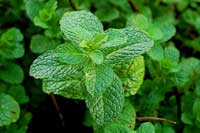
We also take specific precautions depending on the activities. For example, it is vital to correctly identify edible plantsw4, be aware of any local parasites or other health hazards, and not to allow the children to eat anything without the permission of a teacher. Similarly, activities involving fires or bows and arrows must be closely supervised.
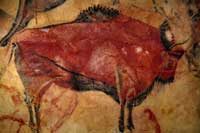
The precise activities you choose for your project will depend on your theme and on the site you use. We have always strived, however, to include hands-on activities. For instance, the year that our theme was horses, we had a real horse that the children could ride and groom, we made horses out of wood and created jewellery for the horse’s mane, to name just a few activities. When we used the theme of pirates, the children made paper boats and raced them on the stream, learned how to sword fight, played games that involved boarding other ships, and made pirate clothes and eye patches.
Whatever the current year’s theme, on the last day, we set up exhibitions of what the different groups have been doing. For example, parents get to see the bows and arrows, and the children explain how they are made and used. The class presents the different types of fuel that they have experimented with in the fire, and demonstrate which ones burn better or less well. The gatherers invite the parents to try the different types of herbs and plants they have collected throughout the week.
As well as being a chance to show off what they have learned, this session reinforces learning by enlarging the children’s vocabulary and teaching them how to present the results of an experiment. At first, we feared this more transparently didactic element of the week on the meadow might make the activities less fun for the children, but in fact it turned out to be a source of motivation. Moreover, it helps broaden the scientific and technical learning of the week by adding a linguistic dimension.
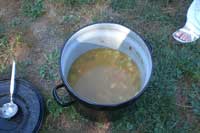
The central part of the final day is cooking up a big pot of soup out of freshly picked vegetables and plants from the meadow and the fields – another opportunity to learn about plants, but also a more general introduction to healthy eating, and a shared experience for children, parents and teachers. For most of our pupils, many of whom come from disadvantaged backgrounds, this is the first time they have tried soup prepared from fresh ingredients. Over the years, we have seen that pupils take the idea of freshly prepared food back home with them – a perfect example of how practical and theoretical elements come together.
The week on the meadow provides a flexible framework in which a range of activities can be anchored, and which can be developed and chosen by the teachers and pupils together. For instance, in addition to the core science content of our week in the meadow, we also find time for songs and games, handicrafts, and have even fitted in a visit from a local beekeeper. It is also an opportunity to bring in outside partners – in our case, the farmer, the beekeeper and the local scout group – further breaking the routine of classroom learning.
Finally, it represents a holistic way of teaching, combining different aspects of science with practical activities that have a real impact on the children’s lives.
Setting up a Stone Age camp for primary-school children is an excellent example of interdisciplinary teaching and learning. It combines physics, environmental education, technology and as many other disciplines as the teacher wishes to include.
The proposed activities are novel and offer an alternative way of teaching many scientific and technological issues such as building a tent, collecting, identifying and naming herbs, and basic mechanics (shooting with an arrow). I am not aware of any school in my country (for either special or mainstream education) that offers such opportunities to its students.
It is probably not easy to organise such an activity but neither would it be impossible. And although the first time might be difficult, the following years should be easier. With proper preparation by the teachers and the appropriate support from the school authorities and the parents, the pupils will gain much more from the project than they would by staying in the classroom setting. In addition, getting help from people or groups (e.g. farmers or scout organisations) outside school should also offer many educational and social benefits to the pupils.
Instead of taking place on a meadow, the activities can undoubtedly also be transferred to a nearby park or riverbank, which are easier to find in a city.
Christiana Nicolaou, Cyprus
Stone Age activities (Word document)
Stone Age activities (PDF file)
Download this article as a PDF